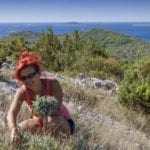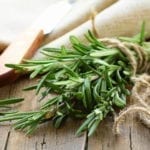Once you get to the Croatian coast, you’ll immediately notice a certain spicy aroma in the air. This comes from wild herbs, get to know them!
Rosemary
A common ingredient in mediterranean cooking, most people buy it dried and some have fresh rosemary growing in a small flower pot. In Croatia, you can find it pretty much anywhere along the coastline. It grows wild in nature, so if you see a rosemary bush on your walk, feel free to pick a few branches. You will often see rosemary shaped as hedges around homes, but that’s private property, and off limits. Once you have your fresh rosemary, you can use it in your olive oil marinade, especially if you’re grilling fish or lamb.
Bay leaf
Bay leaf is another common plant in Dalmatia, and probably simmering in quite a few pots as you are reading this. Feel free to take a few leaves, they are great both fresh and dried. Bay leaf is used in a lot of cuisines, but performs best in slow-cooking dishes like in preparing game, goulash and stews as well as mussels and fish. If you’re cooking with bay leaf, don’t forget to take it out of the meal once it’s done.
Sage
If you’re a fan of sage, Pag is the place for you, the island is known for it. Sage can be used in cooking and for medicinal purposes. It blooms in the peak of the tourist season, in May and July. If you come across some sage, dry it in the sun and prepare some sage tea. It is excellent for the oral cavity and teeth, lungs, digestive problems and bloating.
As a spice, use sage light-handedly because it can overpower other spices and aromas. In the kitchen, Italians prepare it with ravioli, it’s great in pesto, omelettes, with chicken and paired with onions.
Marjoram
This aromatic herb has many applications, it is used to soothe cramps, headaches and migraines, and is the main ingredient of popular essential oils. It’s often mistaken for oregano because of their similar aromas, even though majoran has a more delicate, lemony taste. Marjoram shines in tomato-based dishes and stuffings, pairs beautifully with seafood such as clams, crabs and tuna, but also with chicken, pork and turkey.
Thyme
Thyme is another typical Mediterranean herb. If you pair it with parsley and bay leaves, you will have a bouquet garni, a combination of herbs the French use to season stock, stews and soups. Very fragrant, it’s magnificent in meat marinades, with lamb (yes, Croatians eat a lot of lamb), eggs and cheese, and can withstand long cooking times.
When cooking with thyme, add a whole sprig of thyme to our stew and the leaves will fall off so you can safely remove the wood stem before serving.
Immortelle
Pag is famous for wild-growing immortelle, known as the flower that never fades. Because of its high value in the cosmetic and pharmaceutical industry, illegal pickers ravage Pag for this highly sought after plant, so it is advised not to pick it if you come across it. It takes one ton of immortelle to make one liter of oil that fights the sign of aging, so immortelle is considered endangered. It has anti-aging properties, and is used to treat asthma, liver and gallbladder problems, and migraines.
Congratulation, you’re a herb expert! Now book your perfect vacation and go looking for some.

